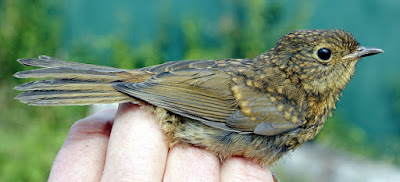I followed up yesterday’s Yellowhammer sighting by going back for pictures on a quiet and sunny Sunday morning. Yellowhammers tend to be late breeders and it’s not unusual to see and hear them in full song in the latter half of the summer. I saw nothing of the female today, just the male sending out his song acrosss the landscape. His mate is obviously sat on a second brood of eggs not too far away from the various song posts.
The Yellowhammer is in poor shape in this part of Lancashire, part of a national and European decline caused by decreased survival rates and agricultural intensification.
I can’t do better than quote from the British Trust for Ornithology (BTO) website and include their graph that really says it all.
“Yellowhammer abundance began to decline on farmland in the mid-1980s. The downward trend has continued to at least 2009, although with substantial increase in Scotland since 2003. The Breeding Bird Survey map of change in relative density between 1994-96 and 2007-09 indicates that in Britain there is a sharp divide between decrease in the east and south and limited increase in the northwest; the population in Northern Ireland has also declined.
Atlas surveys in 2008-11 indicate that range loss in Northern Ireland and western Britain, first noted in 1988-91, has continued strongly. The species, listed as green in 1996, has been red listed since 2002. There has been widespread moderate decline across Europe since 1980.”
Yellowhammer
Less than a mile away I found another male in song, this time from the top of a hawthorn bush. Like many species, Yellowhammers like to sing from a prominent post so as to project their voice far and wide.
Not far away I found a few Jackdaws on typical territory - chimney pots. Yes, Jackdaws increasingly nest in disused chimney pots now that people have central heating rather than fires at the bottom of the chimney. However not everyone likes Jackdaws around their property and a simple mesh can do the trick, but maybe with the addition of a “Keep Out” sign?
“Jackdaws have increased in abundance since the 1960s and more recent Breeding Bird (BBS) Survey data suggest that the increase is continuing in all UK countries. The BBS map of change in relative density between 1994-96 and 2007-09 indicates an increase fairly uniform across the UK range, but with some minor decrease in eastern Scotland. Numbers across Europe have been broadly stable since 1980.
The graph for the Jackdaw is a mirror image of that for the Yellowhammer.
The graph for the Jackdaw is a mirror image of that for the Yellowhammer.
The morning was getting busy with hordes of wannabee Bradley Wiggins' crowding noisily across the carriageways so I made a beeline for the relative quiet of Gulf Lane.
The farmer here is undertaking a Higher Level Stewardship Scheme until 2020/21. He receives Government money via Natural England to set-aside part of his land to enhance wildlife, in this case planting a large field with a wild bird seed mix.
We ringed 208 Linnets here in the winter of 2016/2017 and plan to start ringing very soon and then through to March/April 2018. Let’s hope that next winter there’s no more avian flu in the area to throw a spanner in our essential work to discover what id happening to this Red Listed species.
We ringed 208 Linnets here in the winter of 2016/2017 and plan to start ringing very soon and then through to March/April 2018. Let’s hope that next winter there’s no more avian flu in the area to throw a spanner in our essential work to discover what id happening to this Red Listed species.
There’s a good mix of birds here now - a small flock of Linnets, a couple of Whitethroat, ten or twelve Tree Sparrow, plus a few Reed Bunting and Goldfinch. Next week Andy and I will go and cut a ride through the crop mix in readiness for our first ringing session of the new season.
And finally, in particular for my friend Anni in Texas, here's a Yellowhammer telling us all about his "little bit of bread and no cheese".
And finally, in particular for my friend Anni in Texas, here's a Yellowhammer telling us all about his "little bit of bread and no cheese".
Back soon. Don't miss out.
Linking to Stewart's World Bird Wednesday.





















































































